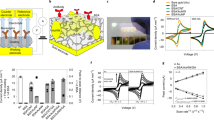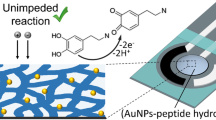Abstract
An antifouling sensing surface was constructed by crosslinking two-dimensional nanomaterial MXene with bovine serum albumin (BSA) denatured by urea previously. The immunoglobulin G (IgG) capture peptide was then modified to the surface to construct a highly selective antifouling electrochemical biosensor. Due to the large specific surface area and good electrical conductivity of MXene, the sensitivity of the biosensor is significantly enhanced. The biosensor at a working potential of around − 0.18 V (vs. Ag/AgCl) provides a wide linear detection range (0.1 ng/mL to 10 µg/mL) for IgG with a limit of detection of 23 pg/mL (3σ/k). The result is consistent with that obtained from the commercial enzyme-linked immunosorbent kit. Compared with BSA, which is usually used as a passivator or blocker for biosensing platforms, the hydrogel formed through the peptide chain obtained from BSA with good hydrophilicity can provide a better antifouling sensing surface to resist nonspecific adsorption. The prepared biosensor can quantitatively detect the concentration of IgG in complex human serum with high sensitivity. Thus, the antifouling sensing surface constructed without expensive antifouling materials and complex process is expected to develop as a variety of electrochemical biosensors and used for the clinical testing of biomarkers.

An antifouling sensing surface was constructed by crosslinking two-dimensional nanomaterial MXene with bovine serum albumin (BSA) denatured by urea previously. The immunoglobulin G (IgG) capture peptide was then modified to the surface to construct a highly selective antifouling electrochemical biosensor.





Similar content being viewed by others
References
Reddy KK, Bandal H, Satyanarayana M, Goud KY, Gobi KV, Jayaramudu T, Amalraj J, Kim H (2020) Recent trends in electrochemical sensors for vital biomedical markers using hybrid nanostructured materials. Adv Sci (Weinh) 7(13):1902980
Singh P, Pandey SK, Singh J, Srivastava S, Sachan S, Singh SK (2016) Biomedical perspective of electrochemical nanobiosensor. Nanomicro Lett 8(3):193–203
Cesewski E, Johnson BN (2020) Electrochemical biosensors for pathogen detection. Biosens Bioelectron 159:112214
Perez D, Orozco J (2022) Wearable electrochemical biosensors to measure biomarkers with complex blood-to-sweat partition such as proteins and hormones. Mikrochim Acta 189(3):127
Singh A, Sharma A, Ahmed A, Sundramoorthy AK, Furukawa H, Arya S, Khosla A (2021) Recent advances in electrochemical biosensors: applications, challenges, and future scope. Biosensors (Basel) 11(9):336
Jiang C, Wang G, Hein R, Liu N, Luo X, Davis JJ (2020) Antifouling strategies for selective in vitro and in vivo sensing. Chem Rev 120(8):3852–3889
Liu S, Guo WW (2018) Anti-biofouling and healable materials: preparation, mechanisms, and biomedical applications. Adv Func Mater 28(41):1800596
Uen T, Kushiro K, Hibino H, Takai M (2020) Surface functionalization of carbon-based sensors with biocompatible polymer to enable electrochemical measurement in protein-rich environment. Sens Actuators B Chem 309:127758
Liu X, Li Y, He L, Feng Y, Tan H, Chen X, Yang W (2021) Simultaneous detection of multiple neuroendocrine tumor markers in patient serum with an ultrasensitive and antifouling electrochemical immunosensor. Biosens Bioelectron 194:113603
Xu Z, Han R, Liu N, Gao F, Luo X (2020) Electrochemical biosensors for the detection of carcinoembryonic antigen with low fouling and high sensitivity based on copolymerized polydopamine and zwitterionic polymer. Sens Actuators B Chem 319:128253
Fan B, Fan Q, Cui M, Wu T, Wang J, Ma H, Wei Q (2019) Photoelectrochemical biosensor for sensitive detection of soluble CD44 based on the facile construction of a poly(ethylene glycol)/hyaluronic acid hybrid antifouling interface. ACS Appl Mater Interfaces 11(27):24764–24770
Goda T, Miyahara Y (2019) Electrodeposition of zwitterionic PEDOT films for conducting and antifouling surfaces. Langmuir 35(5):1126–1133
Nowinski AK, Sun F, White AD, Keefe AJ, Jiang S (2012) Sequence, structure, and function of peptide self-assembled monolayers. J Am Chem Soc 134(13):6000–6005
Xu Y, Wang Z, Ding C, Luo X (2020) Ratiometric antifouling electrochemiluminescence biosensor based on bi-functional peptides and low toxic quantum dots. Sens Actuators B Chem 322:128613
Song Z, Ma Y, Chen M, Ambrosi A, Ding C, Luo X (2021) Electrochemical biosensor with enhanced antifouling capability for COVID-19 nucleic acid detection in complex biological media. Anal Chem 93(14):5963–5971
Wang G, Han R, Li Q, Han Y, Luo X (2020) Electrochemical biosensors capable of detecting biomarkers in human serum with unique long-term antifouling abilities based on designed multifunctional peptides. Anal Chem 92(10):7186–7193
Chen M, Han R, Wang W, Li Y, Luo X (2021) Antifouling aptasensor based on self-assembled loop-closed peptides with enhanced stability for CA125 assay in complex biofluids. Anal Chem 93(40):13555–13563
Xu Y, Wang X, Ding C, Luo X (2021) Ratiometric antifouling electrochemical biosensors based on multifunctional peptides and MXene loaded with Au nanoparticles and methylene blue. ACS Appl Mater Interfaces 13(17):20388–20396
Song Z, Chen M, Ding C, Luo X (2020) Designed three-in-one peptides with anchoring, antifouling, and recognizing capabilities for highly sensitive and low-fouling electrochemical sensing in complex biological media. Anal Chem 92(8):5795–5802
Farghaly AA, Khan RK, Collinson MM (2018) Biofouling-resistant platinum bimetallic alloys. ACS Appl Mater Interfaces 10(25):21103–21112
Khan RK, Silva TA, Fatibello‐Filho O, Collinson MM, Farghaly AA (2022) Nanoporous Pt(Au) alloys for the enhanced, non‐enzymatic detection of hydrogen peroxide under biofouling conditions. Electroanalysis 34:1–10
Yang D (2022) Recent advances in hydrogels. Chem Mater 34(5):1987–1989
Basavalingappa V, Guterman T, Tang Y, Nir S, Lei J, Chakraborty P, Schnaider L, Reches M, Wei G, Gazit E (2019) Expanding the functional scope of the Fmoc-diphenylalanine hydrogelator by introducing a rigidifying and chemically active urea backbone modification. Adv Sci (Weinh) 6(12):1900218
Chen B, Wu P, Liang L, Zhao C, Wang Z, He L, Zhang R, Xu N (2021) Inhibited effect of an RGD peptide hydrogel on the expression of beta1-integrin, FAK, and Akt in Tenon’s capsule fibroblasts. J Biomed Mater Res B Appl Biomater 109(11):1857–1865
Wang W, Han R, Chen M, Luo X (2021) Antifouling peptide hydrogel based electrochemical biosensors for highly sensitive detection of cancer biomarker HER2 in human serum. Anal Chem 93(19):7355–7361
Dhanjai SA, Kalambate PK, Mugo SM, Kamau P, Chen J, Jain R (2019) Polymer hydrogel interfaces in electrochemical sensing strategies: a review. TrAC Trends Anal Chem 118:488–501
Guo L, Ma WB, Wang Y, Song XZ, Ma J, Han XD, Tao XY, Guo LT, Fan HL, Liu ZS, Zhu YB, Wei XY (2020) A chemically crosslinked hydrogel electrolyte based all-in-one flexible supercapacitor with superior performance. J Alloy Compd 843:155895
Li Y, Han R, Chen M, Zhang L, Wang G, Luo X (2021) Bovine serum albumin-cross-linked polyaniline nanowires for ultralow fouling and highly sensitive electrochemical protein quantification in human serum samples. Anal Chem 93(9):4326–4333
Tian L, Zhang Y, Wang L, Geng Q, Liu D, Duan L, Wang Y, Cui J (2020) Ratiometric dual signal-enhancing-based electrochemical biosensor for ultrasensitive kanamycin detection. ACS Appl Mater Interfaces 12(47):52713–52720
Rahmati Z, Roushani M, Hosseini H, Choobin H (2021) Electrochemical immunosensor with Cu2O nanocube coating for detection of SARS-CoV-2 spike protein. Mikrochim Acta 188(3):105
Han C, Guo W (2020) Fluorescent noble metal nanoclusters loaded protein hydrogel exhibiting anti-biofouling and self-healing properties for electrochemiluminescence biosensing applications. Small 16(45):e2002621
Alhabeb M, Maleski K, Anasori B, Lelyukh P, Clark L, Sin S, Gogotsi Y (2017) Guidelines for synthesis and processing of two-dimensional titanium carbide (Ti3C2Tx MXene). Chem Mater 29(18):7633–7644
Li S, Yuan C, Chen J, Chen D, Chen Z, Chen W, Yan S, Hu P, Xue J, Li R, Zheng K, Huang M (2019) Nanoparticle binding to urokinase receptor on cancer cell surface triggers nanoparticle disintegration and cargo release. Theranostics 9(3):884–899
Zhang J, Dong S, Guan L, Zhang D, Huang T (2021) Metal composite oxides Bi2MoO6/IL membrane as matrix for constructing ultrasensitive electrochemical immunosensor. Anal Bioanal Chem 413(4):1173–1183
Shore A, Mazzochette Z, Mugweru A (2015) Mixed valence Mn, La, Sr-oxide based magnetic nanoparticles coated with silica nanoparticles for use in an electrochemical immunosensor for IgG. Microchim Acta 183(1):475–483
Liu N, Hui N, Davis JJ, Luo X (2018) Low fouling protein detection in complex biological media supported by a designed multifunctional peptide. ACS Sens 3(6):1210–1216
Huang Y, Wen Y, Baryeh K, Takalkar S, Lund M, Zhang X, Liu G (2017) Magnetized carbon nanotubes for visual detection of proteins directly in whole blood. Anal Chim Acta 993:79–86
Wu Q, Song D, Zhang D, Sun Y (2016) An enhanced SPR immunosensing platform for human IgG based on the use of silver nanocubes and carboxy-functionalized graphene oxide. Microchim Acta 183(7):2177–2184
Shin MH, Hong W, Sa Y, Chen L, Jung Y-J, Wang X, Zhao B, Jung YM (2014) Multiple detection of proteins by SERS-based immunoassay with core shell magnetic gold nanoparticles. Vib Spectrosc 72:44–49
Funding
The authors received the support of the National Natural Science Foundation of China (22074074), the Natural Science Foundation of Shandong Province (ZR2020MB065), and the Major Scientific and Technological Innovation Project of Shandong Province (2021ZDSYS30).
Author information
Authors and Affiliations
Corresponding author
Ethics declarations
Conflict of interest
The authors declare no competing interests.
Additional information
Publisher's note
Springer Nature remains neutral with regard to jurisdictional claims in published maps and institutional affiliations.
Supplementary information
Below is the link to the electronic supplementary material.
Rights and permissions
Springer Nature or its licensor holds exclusive rights to this article under a publishing agreement with the author(s) or other rightsholder(s); author self-archiving of the accepted manuscript version of this article is solely governed by the terms of such publishing agreement and applicable law.
About this article
Cite this article
Yang, H., Hou, Q. & Ding, C. Denatured bovine serum albumin hydrogel–based electrochemical biosensors for detection of IgG. Microchim Acta 189, 400 (2022). https://doi.org/10.1007/s00604-022-05499-9
Received:
Accepted:
Published:
DOI: https://doi.org/10.1007/s00604-022-05499-9




